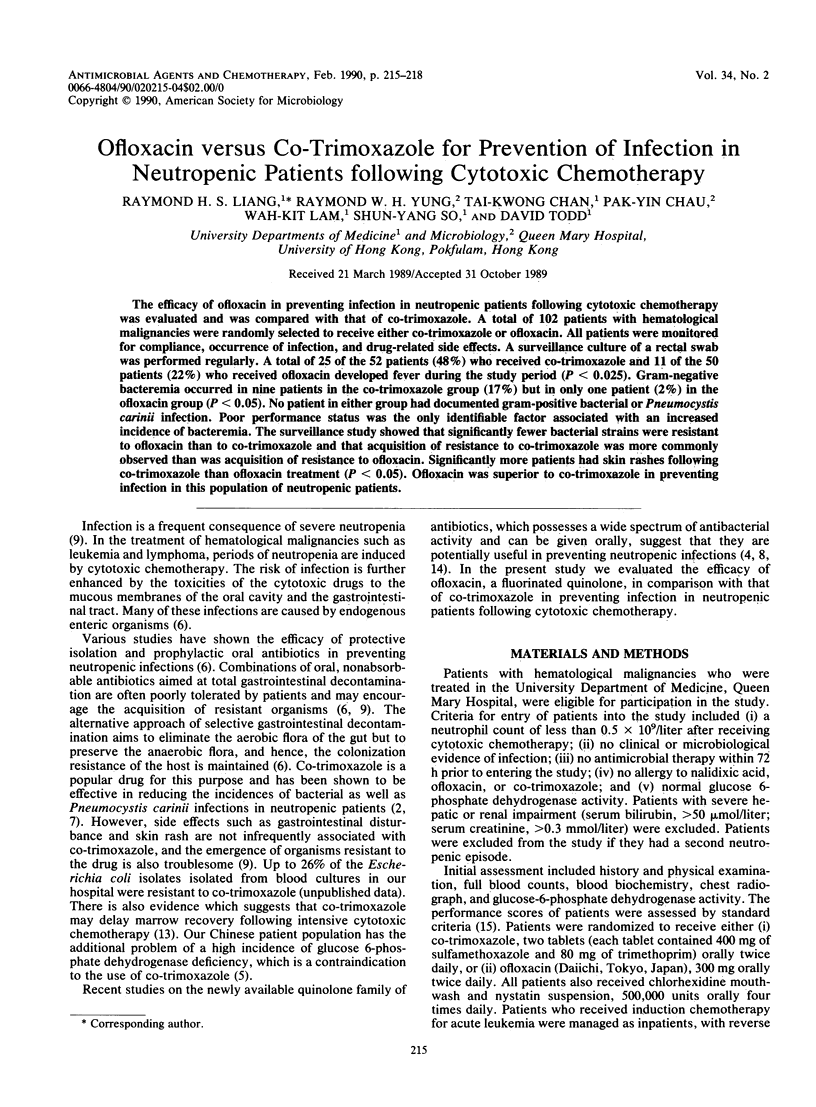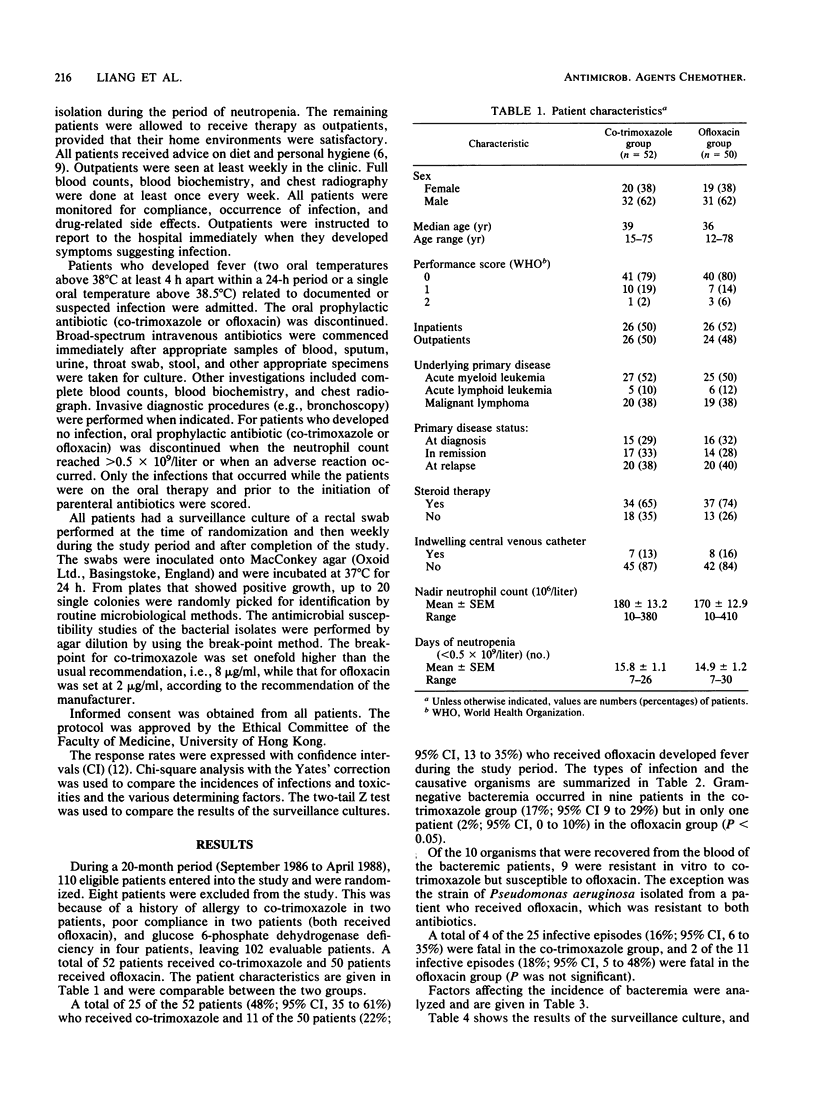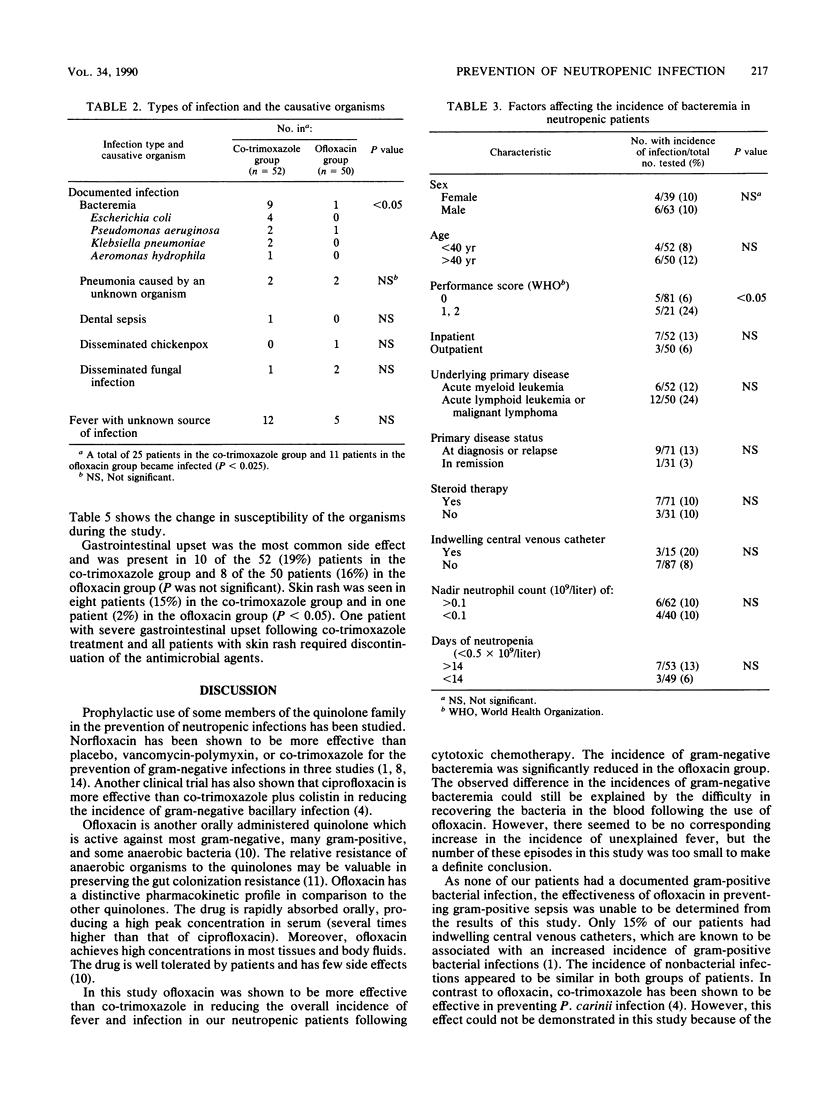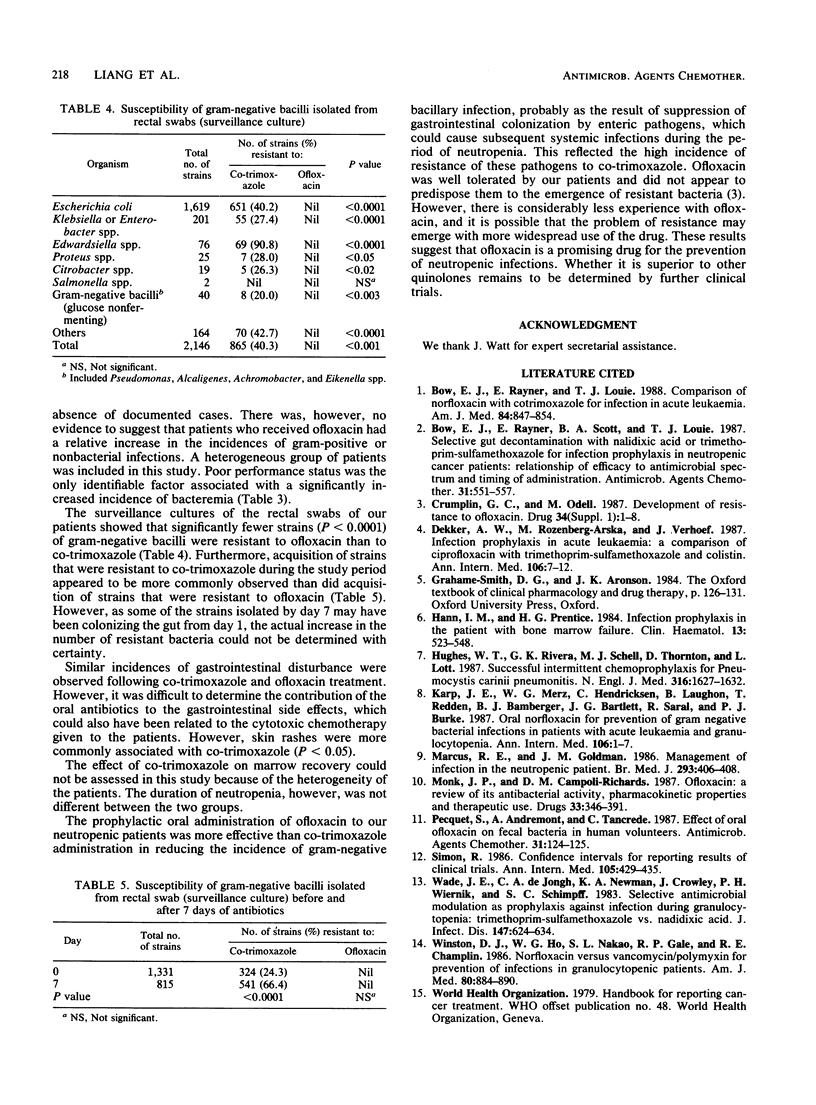Abstract
The efficacy of ofloxacin in preventing infection in neutropenic patients following cytotoxic chemotherapy was evaluated and was compared with that of co-trimoxazole. A total of 102 patients with hematological malignancies were randomly selected to receive either co-trimoxazole or ofloxacin. All patients were monitored for compliance, occurrence of infection, and drug-related side effects. A surveillance culture of a rectal swab was performed regularly. A total of 25 of the 52 patients (48%) who received co-trimoxazole and 11 of the 50 patients (22%) who received ofloxacin developed fever during the study period (P less than 0.025). Gram-negative bacteremia occurred in nine patients in the co-trimoxazole group (17%) but in only one patient (2%) in the ofloxacin group (P less than 0.05). No patient in either group had documented gram-positive bacterial or Pneumocystis carinii infection. Poor performance status was the only identifiable factor associated with an increased incidence of bacteremia. The surveillance study showed that significantly fewer bacterial strains were resistant to ofloxacin than to co-trimoxazole and that acquisition of resistance to co-trimoxazole was more commonly observed than was acquisition of resistance to ofloxacin. Significantly more patients had skin rashes following co-trimoxazole than ofloxacin treatment (P less than 0.05). Ofloxacin was superior to co-trimoxazole in preventing infection in this population of neutropenic patients.
Full text
PDF



Selected References
These references are in PubMed. This may not be the complete list of references from this article.
- Bow E. J., Rayner E., Louie T. J. Comparison of norfloxacin with cotrimoxazole for infection prophylaxis in acute leukemia. The trade-off for reduced gram-negative sepsis. Am J Med. 1988 May;84(5):847–854. doi: 10.1016/0002-9343(88)90062-9. [DOI] [PubMed] [Google Scholar]
- Bow E. J., Rayner E., Scott B. A., Louie T. J. Selective gut decontamination with nalidixic acid or trimethoprim-sulfamethoxazole for infection prophylaxis in neutropenic cancer patients: relationship of efficacy to antimicrobial spectrum and timing of administration. Antimicrob Agents Chemother. 1987 Apr;31(4):551–557. doi: 10.1128/aac.31.4.551. [DOI] [PMC free article] [PubMed] [Google Scholar]
- Crumplin G. C., Odell M. Development of resistance to ofloxacin. Drugs. 1987;34 (Suppl 1):1–8. doi: 10.2165/00003495-198700341-00002. [DOI] [PubMed] [Google Scholar]
- Dekker A. W., Rozenberg-Arska M., Verhoef J. Infection prophylaxis in acute leukemia: a comparison of ciprofloxacin with trimethoprim-sulfamethoxazole and colistin. Ann Intern Med. 1987 Jan;106(1):7–11. doi: 10.7326/0003-4819-106-1-7. [DOI] [PubMed] [Google Scholar]
- Hann I. M., Prentice H. G. Infection prophylaxis in the patient with bone marrow failure. Clin Haematol. 1984 Oct;13(3):523–547. [PubMed] [Google Scholar]
- Hughes W. T., Rivera G. K., Schell M. J., Thornton D., Lott L. Successful intermittent chemoprophylaxis for Pneumocystis carinii pneumonitis. N Engl J Med. 1987 Jun 25;316(26):1627–1632. doi: 10.1056/NEJM198706253162604. [DOI] [PubMed] [Google Scholar]
- Karp J. E., Merz W. G., Hendricksen C., Laughon B., Redden T., Bamberger B. J., Bartlett J. G., Saral R., Burke P. J. Oral norfloxacin for prevention of gram-negative bacterial infections in patients with acute leukemia and granulocytopenia. A randomized, double-blind, placebo-controlled trial. Ann Intern Med. 1987 Jan;106(1):1–7. doi: 10.7326/0003-4819-106-1-1. [DOI] [PubMed] [Google Scholar]
- Marcus R. E., Goldman J. M. Management of infection in the neutropenic patient. Br Med J (Clin Res Ed) 1986 Aug 16;293(6544):406–408. doi: 10.1136/bmj.293.6544.406. [DOI] [PMC free article] [PubMed] [Google Scholar]
- Monk J. P., Campoli-Richards D. M. Ofloxacin. A review of its antibacterial activity, pharmacokinetic properties and therapeutic use. Drugs. 1987 Apr;33(4):346–391. doi: 10.2165/00003495-198733040-00003. [DOI] [PubMed] [Google Scholar]
- Pecquet S., Andremont A., Tancrède C. Effect of oral ofloxacin on fecal bacteria in human volunteers. Antimicrob Agents Chemother. 1987 Jan;31(1):124–125. doi: 10.1128/aac.31.1.124. [DOI] [PMC free article] [PubMed] [Google Scholar]
- Simon R. Confidence intervals for reporting results of clinical trials. Ann Intern Med. 1986 Sep;105(3):429–435. doi: 10.7326/0003-4819-105-3-429. [DOI] [PubMed] [Google Scholar]
- Wade J. C., de Jongh C. A., Newman K. A., Crowley J., Wiernik P. H., Schimpff S. C. Selective antimicrobial modulation as prophylaxis against infection during granulocytopenia: trimethoprim-sulfamethoxazole vs. nalidixic acid. J Infect Dis. 1983 Apr;147(4):624–634. doi: 10.1093/infdis/147.4.624. [DOI] [PubMed] [Google Scholar]
- Winston D. J., Ho W. G., Nakao S. L., Gale R. P., Champlin R. E. Norfloxacin versus vancomycin/polymyxin for prevention of infections in granulocytopenic patients. Am J Med. 1986 May;80(5):884–890. doi: 10.1016/0002-9343(86)90633-9. [DOI] [PubMed] [Google Scholar]


